Featured image credit: Pavel Kassin/ ROSCOSMOS
Lift Off Time | December 8, 2021 – 07:38:15 UTC | 10:38:15 MSK |
|---|---|
Mission Name | Soyuz MS-20, crewed flight to the International Space Station (ISS) |
Launch Provider | ROSCOSMOS |
Customer | Yusaku Maezawa (space tourist) through Space Adventures, Inc. |
Rocket | Soyuz 2.1a |
Launch Location | Launch Complex 31/6, Baikonur Cosmodrome, Kazakhstan |
Payload mass | 162 kg (357 Ibs) of cargo |
Where did the spacecraft go? | It rendezvoused with the ISS, ~400 km low Earth orbit (LEO) at a 51.66° inclination |
Did they attempt to recover the first stage? | No, this is not a capability of Soyuz |
Where did the first stage land? | The boosters crashed into the steppes of Kazakhstan |
Did they attempt to recover the fairings? | No, this is not a capability of Soyuz |
Were these fairings new? | Yes |
This was the: | – 4th crewed mission to the ISS in 2021 – 9th space tourism mission to the ISS executed by Space Adventures – 13th launch from the Baikonur Cosmodrome of 2021 – 57th mission of Soyuz 2.1a rocket – 148th flight of a crewed Soyuz spacecraft – 126th orbital launch attempt of 2021 (119th successful) |
Where to re-watch | Launch: Official ROSCOSMOS replay Official Japanese replay Docking: Official ROSCOSMOS replay Hatches opening: Official ROSCOSMOS replay |
How Did It Go?
Soyuz MS-20 is a crewed flight to the International Space Station (ISS) that launched on December 8, 2021. This mission was quite different from all the previous flights of the Soyuz spacecraft. This is because it did not bring any crew members to the ISS Expedition. Instead, this flight was fully dedicated to space tourism. The crew included commander Alexander Misurkin and two space tourists from Japan: Yusaku Maezawa and Yozo Hirano who will stay at the ISS for 12 days. ROSCOSMOS launched this mission using a Soyuz MS spacecraft atop a Soyuz 2.1a launch vehicle. The rocket lifted off from Launch Complex 31/6, at the Baikonur Cosmodrome in Kazakhstan.
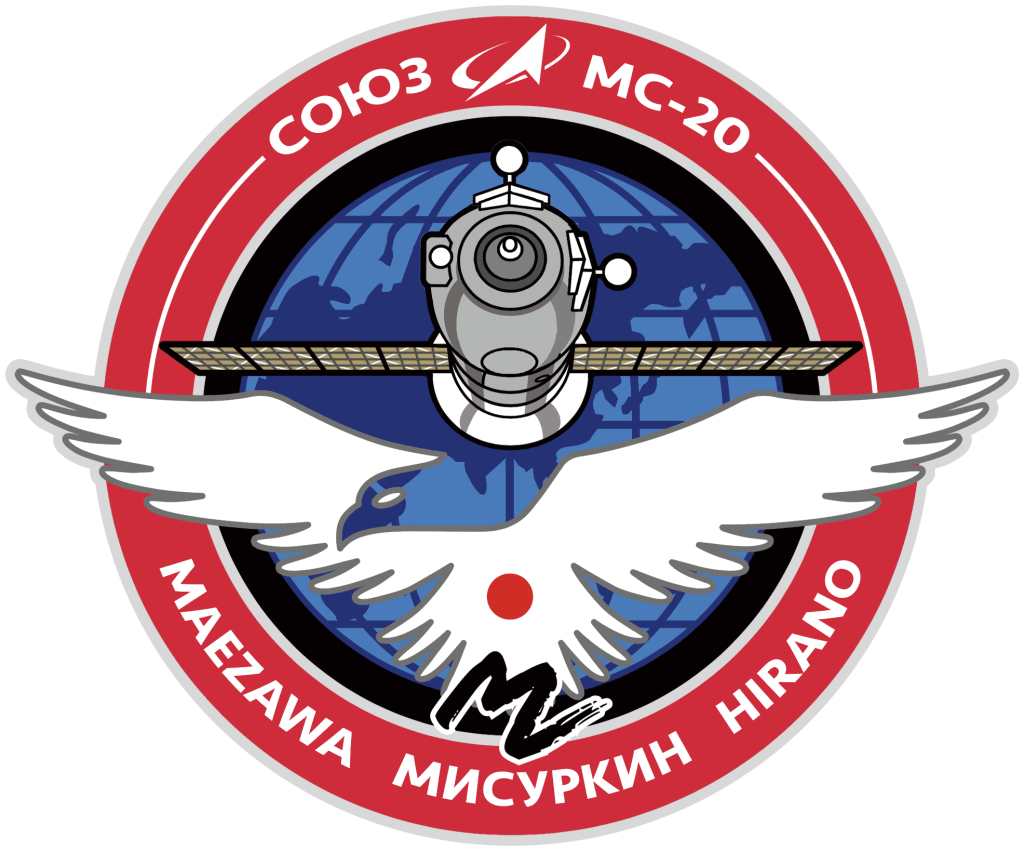
The mission patch has a Soyuz MS spacecraft on it, as well as an eagle with spread wings. This bird is reminiscent of Oryol city in Russia (“Oryol” means “eagle” in Russian) where Alexander Misurkin grew up.
Soyuz MS-20 Mission
Space Adventures, Inc.
Space Adventures, Inc. is an American space tourism company that was founded in 1998 and to date has arranged 7 missions for civilians. Their first mission took place in April 2001 with Dennis Tito (American businessman) traveling to the ISS on Soyuz TM-32. The main objective of this company is to provide an opportunity for “as many people as possible to experience what it is like to live in space, to circle the Earth, or travel beyond Earth orbit”.
Like on the previous crewed Soyuz MS-19 mission, the spacecraft was piloted by a single person, ROSCOSMOS cosmonaut Alexander Misurkin. Therefore, he carried out the functions of both commander and flight engineer. For that, the Soyuz MS spacecraft and its replica at the training center were upgraded with a portable remote control for critical commands that are usually executed by a flight engineer.
Alexander Misurkin shared in his social media that Grogu (Baby Yoda) happens to be a Zero-G indicator for this mission.

Training
The crew started its training on June 15, 2021, at the Yuri Gagarin Research & Test Cosmonaut Training Center. During the first session (June-September), Yusaku Maezawa and Yozo Hirano familiarized themselves with the Soyuz MS spacecraft and the Russian segment of the ISS, worked with on-board systems and equipment, and learnt how the crew’s activities are organized both in the spacecraft and at the ISS. The second half of the training (September-December) was dedicated to medical and biological training, learning about survival in different geographical zones, and final exams. Moreover, they have been trained to deal with emergency situations such as depressurization, fire, and problems that may occur during the landing.

On November 2, the medical committee announced that both the main and backup crews were ready for the launch. Then, on November 16, they successfully passed all the necessary exams to go to the ISS. On November 20, the Soyuz MS-20 crew tried on Sokol KV-2 suits, performed a leak test, and familiarized themselves with the Soyuz MS-20 spacecraft. Finally, on December 2, the Soyuz MS-20 crew performed a check inspection of the spacecraft.
LAZMA Medical Experiment
The crew will participate in the LAZMA medical experiment that was developed by Oryol State University and will be conducted at the ISS for the first time. This study aims to investigate blood microcirculation in microgravity conditions. For that, the crew will have laser sensors installed on the upper and lower extremities, as well as on the head in the area of the temples. These analyzers will capture the changes in blood flow of all skin vessels. The readings obtained at the ISS will be supplemented with the data collected before launch, in spaceflight, and after landing. This study will help to better understand processes of blood flow in microgravity and also to develop preventive measures against circulatory disorders that are especially important for future deep-space missions.
Cargo
The Soyuz MS-20 was one of the last missions to the ISS before New Year and Christmas (it is celebrated on January 7 in Russia). That is why it carried a lot of presents and letters from families for Peter Dubrov and Anton Shkaplerov, as well as some equipment for medical and biological experiments, food, 13 kg of fruit, hygiene items, and other cargo. Overall, this mission brought approximately 162 kg of cargo to support the Expedition 66 at the ISS.

Who Was On Soyuz MS-20?
Each crew member plays a crucial role in the safe travel from the launch pad to the ISS. This time, the Soyuz capsule included a commander and two civilians. It is not unusual for astronauts from other countries to fly on a Soyuz capsule, as there is normally at least one astronaut from another agency accompanying a Russian commander. Flying on Soyuz MS-20 were ROSCOSMOS cosmonaut Alexander Misurkin (commander), Yusaku Maezawa (space tourist), as well as Yozo Hirano (space tourist).
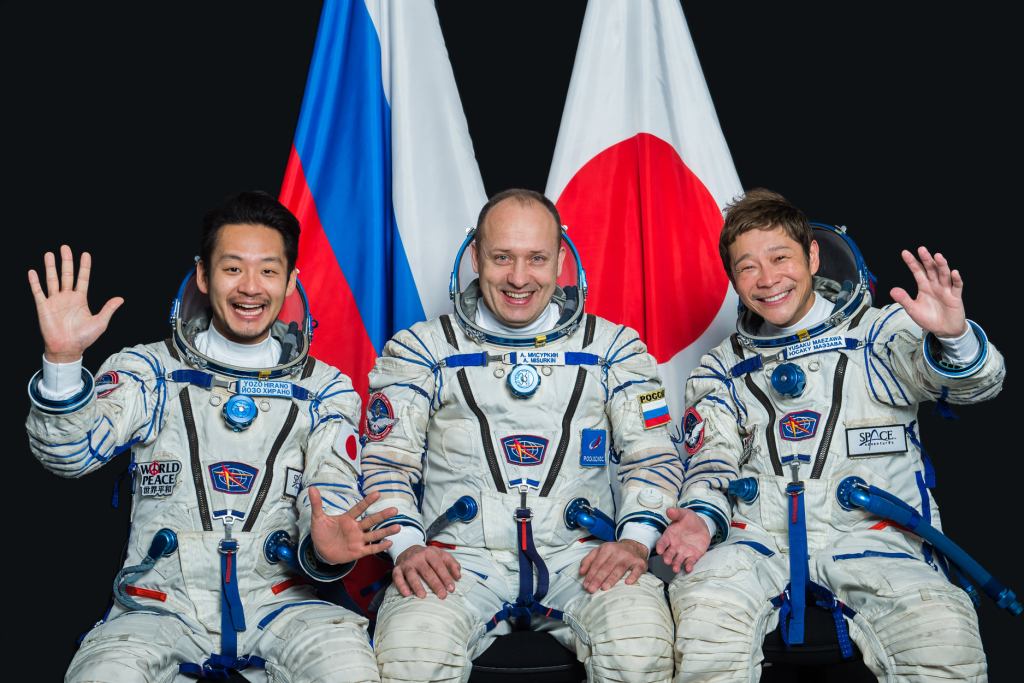

Alexander Misurkin (Commander)
Born in 1977, Alexander Misurkin attended Kachinsk Higher Military Aviation School and then Armavir Military Aviation Institute. After graduation, he worked as a senior pilot. Misurkin was qualified as a cosmonaut in 2009, after completing a basic space training program.
Misurkin has a website where he publishes posts, pictures, and videos to popularize space in Russia and worldwide.
This was Alexander Misurkin’s third spaceflight, all of which occurred on Soyuz vehicles. Misurkin first flew on the Soyuz TMA-08M spacecraft and was a flight engineer during Expedition 35/36 aboard the ISS. After his first mission, he launched on the Soyuz MS-06 in 2017 as commander of the spacecraft and Expedition 53/54.

Yusaku Maezawa (Space Tourist)
Born in 1975, Yusaku Maezawa is a Japanese e-commerce entrepreneur and world renowned art collector. After graduating from high school, he moved to the US and started collecting CDs and records. This collection is what became the foundation of his first company that sold CDs through the mail and then online. With time, this company transformed into Start Today, a publicly traded online retail clothing business.
This was Maezawa’s first flight to space. He will be documenting his daily life on the ISS and sharing it with the world on his YouTube channel.

Yozo Hirano (Space Tourist)
Born in Ehime Prefecture, Japan in 1985, Yozo Hirano is Maezawa’s personal assistant. He joined the company shortly after graduating from university and was in charge of management of the photography team.
Later, he left the company and started working as a personal assistant, producer and manager for Maezawa’s private projects, including his YouTube channel.
This was Hirano’s first flight to space. He will be in charge of documenting Maezawa’s daily life on the ISS.
The backup crew included ROSCOSMOS cosmonaut Alexander Skvortsov and space tourist Shun Ogiso (public relations manager of Start Today corporation).
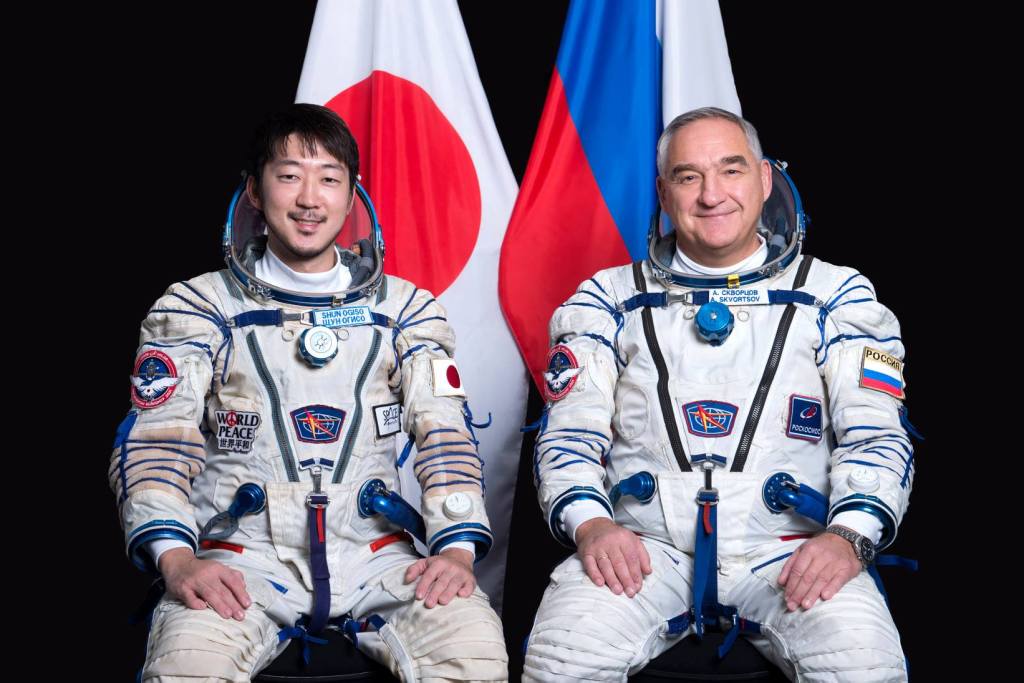
Soyuz MS-20 Mission’s Profile
For this flight, ROSCOSMOS used a rendezvous technique that allows reaching the ISS in four orbits or about six hours. The Soyuz MS-20 docked to the ISS (Poisk module) on December 8, at 13:46:40 UTC (16:46:40 MSK). The crew will stay at the ISS for 12 days. After that, on December 20, they will return to the Earth. The spacecraft will undock from the ISS on December 19, at 23:56 UTC (December 20, at 02:56 MSK) and is scheduled to land three hours later at 03:18 UTC (06:18 MSK).

Approximate Timeline
| Hrs:Min:Sec From Lift-Off | Events |
| – 00:00:15 | Engine start sequence |
| 00:00:00 | Lift-Off |
| + 00:01:53 | Escape tower jettison |
| + 00:01:58 | First stage separation |
| + 00:02:33 | Fairing jettison |
| + 00:04:47 | Second stage separation |
| + 00:04:55 | Tail section separation |
| + 00:08:46 | Third stage main engine cutoff |
| + 00:08:49 | Soyuz MS separation |
What Is Soyuz 2.1a?
ROSCOSMOS’s Soyuz is a multi-use medium-lift launch vehicle that was introduced in 1966 and since then has been the workhorse of the Soviet/Russian space program. It is able to launch civilian and military satellites, as well as cargo and crewed missions to the ISS. Over the decades, several variants of the Soyuz rocket have been developed. Soyuz 2.1a is one of its latest iterations that belongs to the Soyuz-2 rocket family.
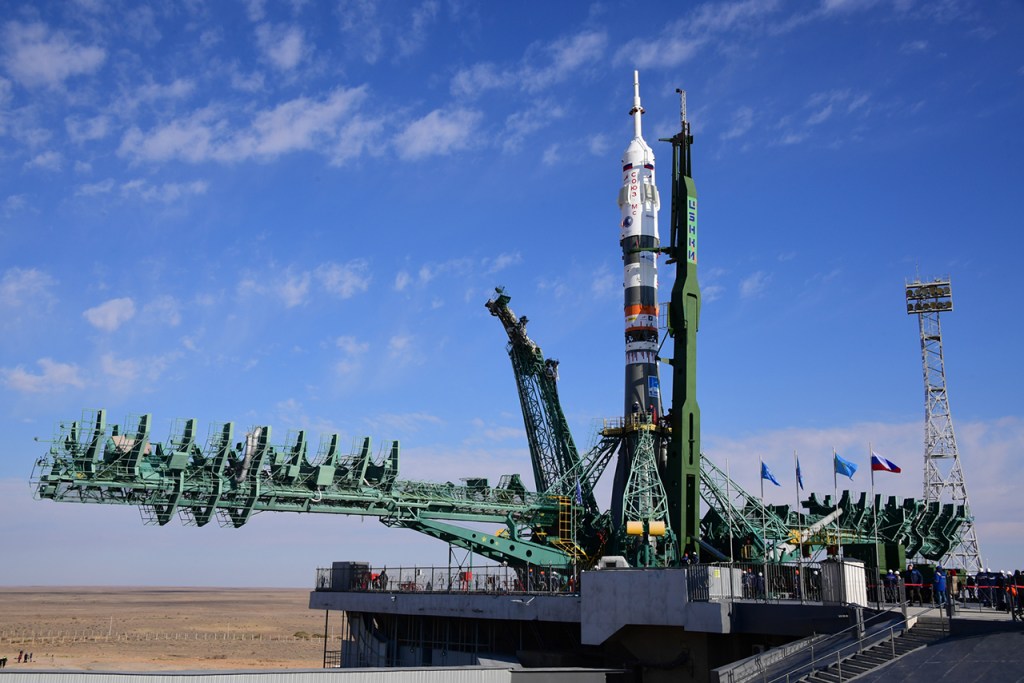
The rocket consists of three stages, all of them are expendable. When launching to the ISS, Soyuz-2 can be flown with either a Progress capsule or a Soyuz spacecraft. On the Soyuz MS-20 mission, the Soyuz MS spacecraft was used.
Soyuz 2.1a is about 46.3 meters (152 ft) in height and 2.95 meters (9 feet) in diameter. The vehicle’s total lift-off mass is approximately 312,000 kg (688,000 lb). The rocket’s payload lift capacity to low-Earth orbit (LEO) is between 6,600 and 7,400 kg depending on the launch site.
Stages
| First Stage | Second Stage | Third Stage | |
| Engine | 4 RD-107A | RD-108A | RD-0110 |
| Total Thrust | 840 kN (188,720 lbf), sea level 1,020 kN (229,290 lbf), vacuum | 792 kN (178,140 lbf), sea level 922 kN (207,240 lbf), vacuum | 298 kN (67,000 lbf), vacuum |
| Specific Impulse (ISP) | 263 s, sea level 320 s, vacuum | 258 s, sea level 321 s, vacuum | 326 s, vacuum |
Side Boosters
The first stage of the Soyuz 2.1a rocket is composed of 4 side boosters that are powered by RD-107A engines. Each one of the boosters has a conical shape and a dry weight of 3,784 kg. It is approximately 19.6 meters in length, with a diameter of 2.7 meters. Each side booster has two vernier thrusters that are used for flight control.
The RD-107A engine runs on rocket-grade kerosene (RP-1) and liquid oxygen (LOx). The propellants are stored in the pressurized aluminum alloy tanks, the kerosene tank is located in the cylindrical part of the booster, and the LOx tank is in the conical section. Each one of those engines has 4 combustion chambers and together they are capable of producing a thrust of 840 kN at sea level and 1,020 kN in a vacuum.
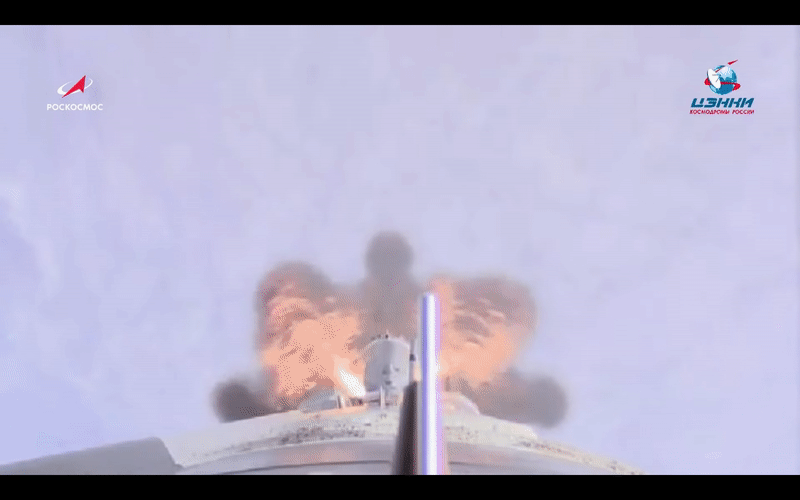
Perhaps, the most spectacular moment of the Soyuz-2 rocket’s launch is the separation of the first stage. It happens approximately 2 minutes after the launch. The boosters perform a pattern, known as the “Korolev cross” (named after Sergei Korolev, a very important figure of the USSR space program and history).
Second And Third Stages
The center core stage is powered by a single RD-108A engine, and the upper stage is fitted with a single RD-0110 engine. Both of these engines run on rocket-grade kerosene and LOx and have 4 combustion chambers. The second stage is 27.10 meters long, with a diameter of 2.95 meters, and a dry mass of 6,545 kg. It has 4 vernier thrusters for three-axis flight control.
The third stage of a Soyuz-2 rocket has a height of 6.7 meters, a diameter of 2.7 meters, and a dry mass of 2,355 kg. One interesting thing about the engine on this stage is that it starts its ignition sequence prior to stage separation. This process is called “hot fire staging”.
Soyuz MS Spacecraft
The Soyuz MS spacecraft is the latest version of Russia’s long-standing three-person spacecraft. Soyuz capsules first flew in the 1960s. The spacecraft’s external appearance is largely unchanged over this time. However, the internal systems and capabilities have been upgraded many times.
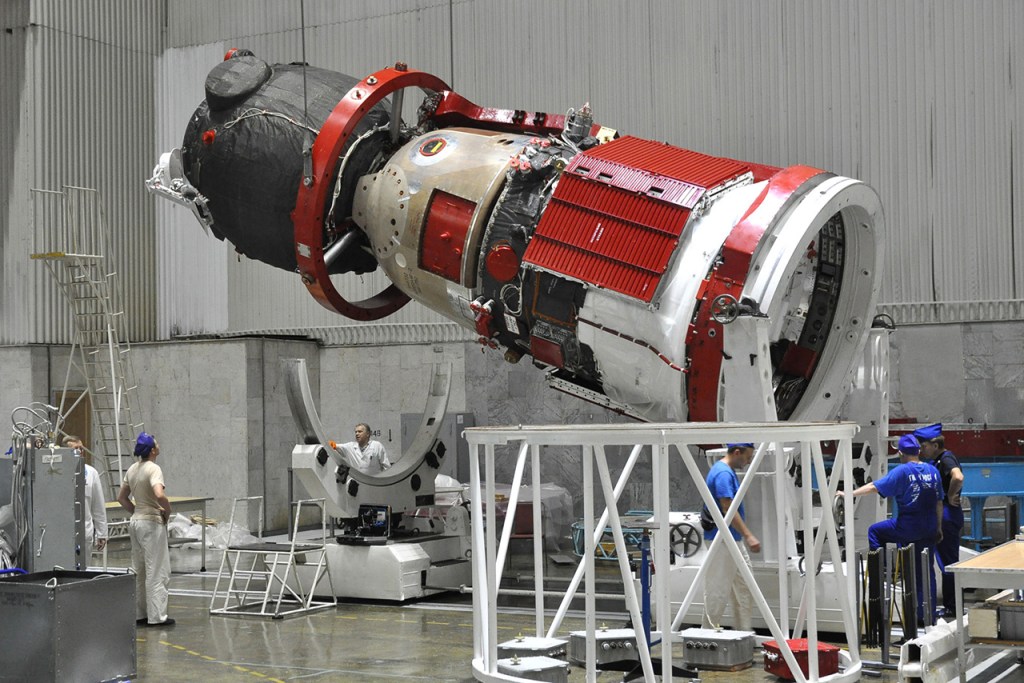
The Soyuz MS variant is one of the versions from the fourth generation of this spacecraft. Its first flight was in 2006. Soyuz consists of three sections:
- the orbital module
- the descent module
- the service module
The Orbital Module
This is the forward section of the spacecraft, the part that docks to the ISS. It is the part of the spacecraft where the crew will spend most of their time on orbit. It has more living room than the descent module. On the Progress uncrewed resupply missions, this is replaced by a cargo module.
The Descent Module
This is the middle section of the spacecraft. It is the only part that returns intact to land on Earth. This is where the crew will sit during the launch and the reentry. They will be wearing spacesuits in case of capsule depressurization. There is very little room for the crew of three in this module. On the Progress uncrewed resupply missions, this is replaced by a refueling module that can transfer fuel into the Russian segment. This can then be used by thrusters on the ISS to boost its orbit.
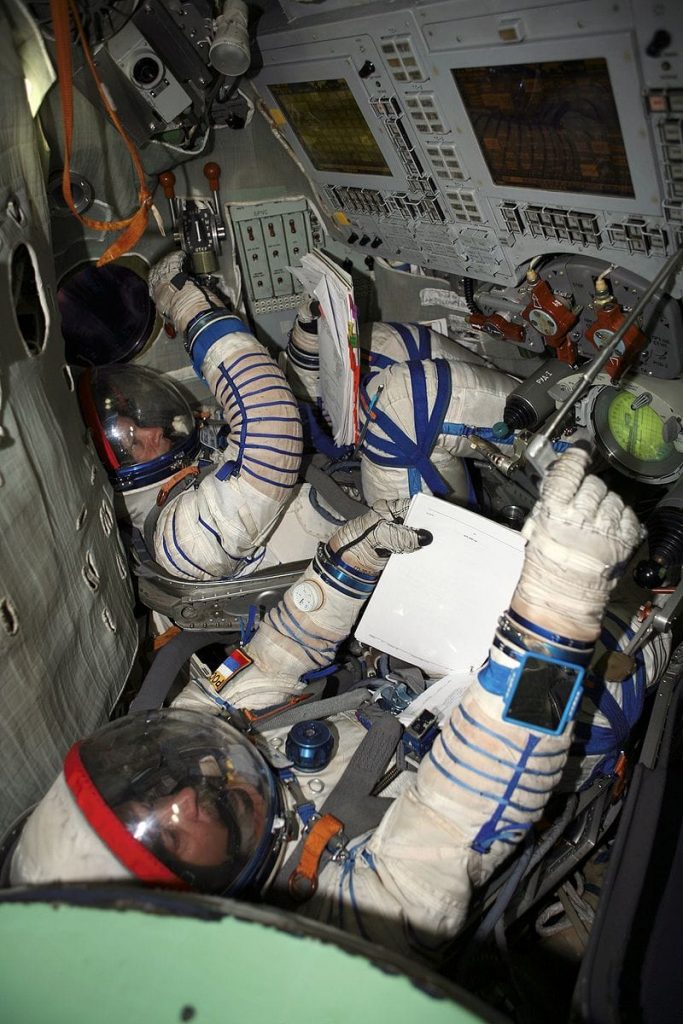
The Service Module
This is the aft (rear) section of the spacecraft. It provides the main engine used for manoeuvring on orbit and the thrusters for fine control during docking and departure. Also, it also contains the life support system for environmental control of the rest of the spacecraft. In addition, it also supports the solar panels and various radio communication systems.
Kurs-NA Automatic Docking System
Like the Progress MS, the Soyuz spacecraft is equipped with a Kurs-NA automatic docking system that was first tested on the Progress M-15M mission in July 2012. Compared to its ancestor, Kurs-A, the new system has only one AO-753A rendezvous antenna. Kurs-A had five (two 2AO-VKA and three AKR-VKA) of them. This antenna broadcasts radar pulses that are needed to determine the altitude and relative position of the spacecraft to the ISS. Moreover, Kurs-NA uses less power than Kurs-A.
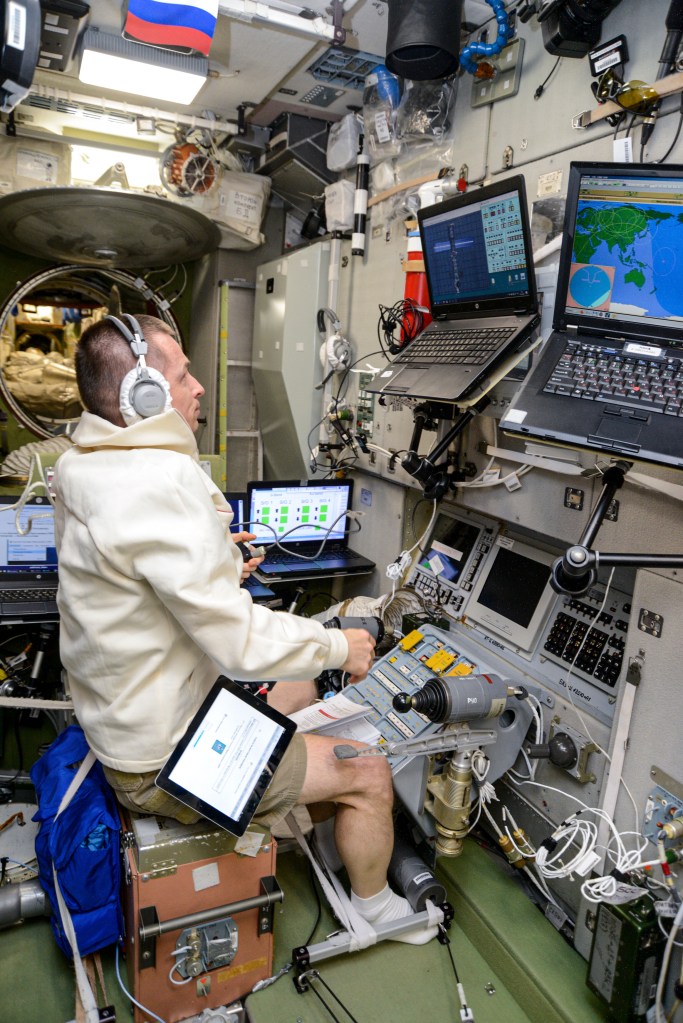
In addition, the Soyuz spacecraft can be docked to the ISS manually by the docking system called the Tele-Robotically Operated Rendezvous unit (TORU). This manual system serves as a backup to Kurs-NA in emergency situations and is located inside the Zvezda service module.
Soyuz MS Spacecraft section adapted from Andy Law.





